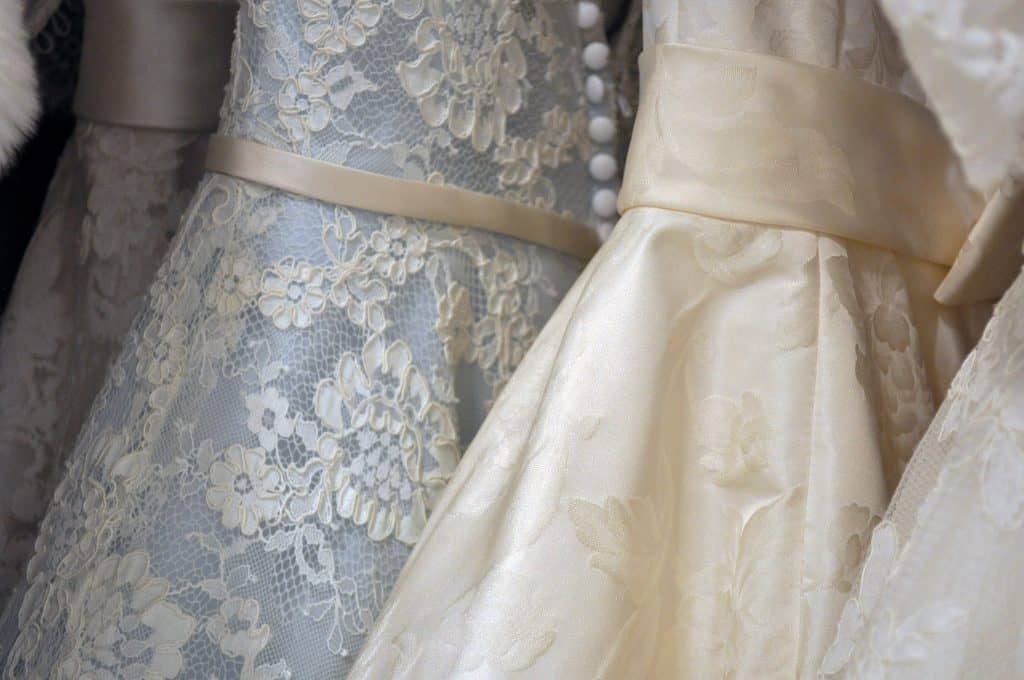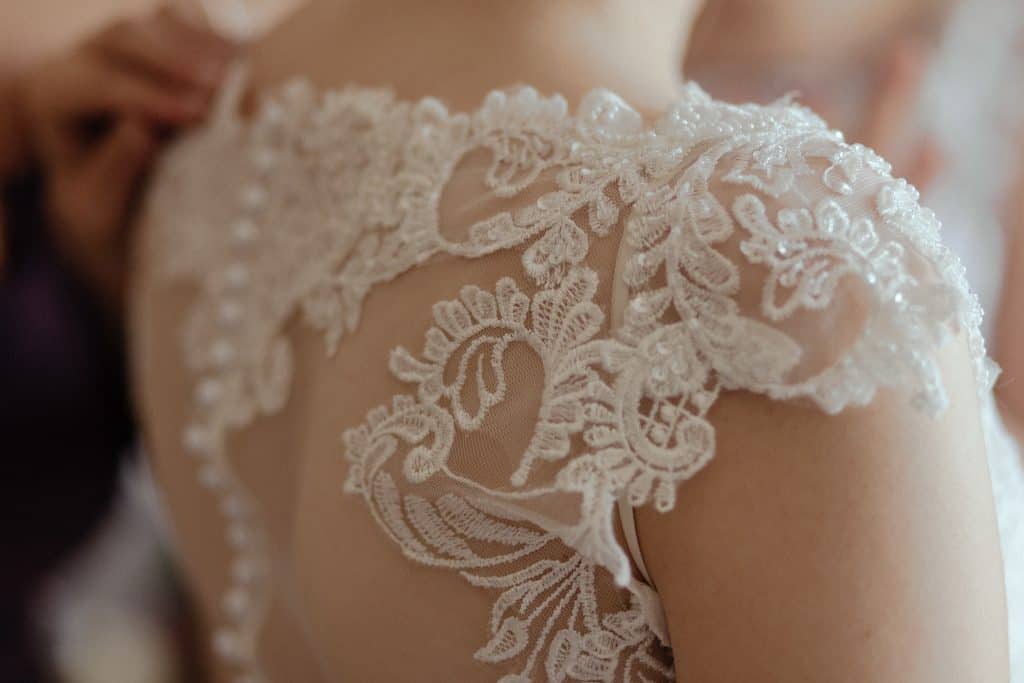After what was likely one of the happiest days of your life, you probably put your bridal gown in a closet or storage unit and forgot about it. When stored in plastic or exposed to sunlight, formal wear can become discoloured.
Stains that initially appear clear, such as those left by carbonated beverages or alcohol, may take some time to turn yellow and become more obvious. The yellowing of your dress can be undone, and you can have it restored to its original whiteness.
All fabrics eventually wear out, including your bridal gown. Once the entire fibres deteriorate chemically due to flaws in the textile's production or care, the result is a yellowing of the fabric. White but also pastel fabrics deteriorate quickly, turning the typical wedding dress a pale to medium yellow. Chemical reactions can also leave permanent brown or black stains on vintage garments.
Wedding gowns do indeed turn yellow over time. When exposed to environmental stresses such as strong sunlight, high humidity, and high temperature, natural fibres deteriorate more quickly. Even plastic garment bags won't prevent dresses from phenolic yellowing. Fabrics or the chemicals inside the plastic suit case react chemically, causing a yellowing effect known as phenolic.
You looked beautiful in that wedding dress. As a matter of fact, this is how the vast majority of women who will one day be wives feel. They hope that their daughters will continue to wear it to weddings in the future. However, exposure to heat, light, and poor storage conditions can cause even the whitest and brightest wedding dress to fade to yellow. It's a shame that no future brides can take advantage of this. Even though the yellowing on your wedding dress is unavoidable, it is not beyond repair. Find out how to breathe new life into your wedding dress with these tried and true techniques.
Looking for the ultimate Wedding Reception Venue in Melbourne? Look no further, Vines of the Yarra Valley is here.
Table of Contents
So, why does clothing fade to a dull yellow?
With regards to the textile market, fabric yellowing has been a problem for a very long time. It's terrible news for brides because whites and pastels tend to yellow the fastest. As for the question of why wedding dresses turn yellow, the chemical decomposition of the fabric fibres is to blame. This indicates that the chemical components of the fabric, which were previously colourless, have begun to degrade and have taken on a light to moderate yellow hue as a result. Dark brown stains often appear on older gowns after being stored for a long time, indicating chemical decomposition.
Sadly, your wedding dress will eventually wear out like most fabrics will. Fabrics turn yellow when the original fibres deteriorate chemically due to flaws in the textile's production or care. White and pastel fabrics fade quickly, turning the typical wedding dress a light to medium shade of yellow after a few years. These chemical changes can also permanently stain antique clothing a dark brown or black colour.
A wedding dress turning yellow is not just a myth. Sunlight, humidity, and heat all contribute to the rapid deterioration of natural fibres. Phenolic yellowing is almost inevitable if you store your dress in a plastic garment bag, even with the utmost care. Phenolic yellowing results from a chemical reaction triggered by the interaction of fabrics and the chemicals in the plastic garment bag.
Fabric yellowing is a well-known, widespread problem. The reason for this is that nowadays, more and more bridal gowns are made of a combination of natural and synthetic fibres.
Avoiding the yellowing of your wedding dress is a tall order, especially if you're doing it on your own. The best option is to hire a professional wedding dress preservation service. Wedding dresses can be returned to their old colour with the help of modern techniques and products at professional preservation facilities. Although it may look nearly spotless right now, the yellowing of your dress is inevitable. Eventually, the stains (such as those left by sweat, perfume, or white wine) will become noticeable as brown spots.
What caused the yellowing of my wedding dress?
Thereafter, we can say that a change in the fabric's chemical composition is responsible for the yellowing, we can begin to look into what may have contributed to the breakdown of the materials used to make your wedding dress.
Fiber Deterioration
The failure of your gown's fibres can be accelerated by exposure to light radiation, excessive heat, and high humidity. Although these have an extended negative impact, fibre deterioration is probably not the primary cause of your yellowing gown.
Chemical Enhancements
There is nothing the bride could have done to prevent the yellowing of her wedding dress, as chemicals used in the fabric's production are often to blame. Misformulated chemical formula and Long-term holding can lead to the breakdown of chemicals used in softeners (such as chlorine, waxes, oils, etc.). It's not just that these chemicals speed up yellowing; they can also attract and bind potentially damaging particles like dirt, oils, and dust that were present at your wedding.
Environmental Pollutants
Toxic air pollutants, especially nitrogen, can cause fabric yellowing and damage. These oxidizers may enter the atmosphere through a variety of manmade and natural channels, including vehicles, heating systems, and industrial processes. Air pollution can cause a gown's outer layer to yellow, but this is usually superficial. Therefore, the conservation facility that will be caring for your dress will have modern air purification and circulation systems installed to guarantee that no airborne contaminants will damage your garments while in storage.
Transferred Contaminants
During the time it is stored before or after purchase, your dress may be exposed to contaminants that are transferred from other garments. Fabric discoloration, or "phenolic yellowing," has been associated with the use of polythene (plastic) bags. Similar to how plastics can contribute to phenolic yellowing, acidic papers, cardboard, and other types of packaging materials can as well. The tissue paper without acids, and storage box found in the wedding dress preservation kit serve to stop the spread of contaminants over time.
Consumer Contaminants
Envision that today is your wedding day. In the course of a typical day, your wedding gown is exposed to a variety of pollutants that could get stuck to or absorbed by the fabric. It's gross: grass stains, body lotion from a photo shoot outside, wine stains sugar stains left over from slicing the cake, reapplied perfume, dance floor covered in sweat., and so on. Were we to have to live with these stains, could we? Naturally, we concur and exclaim our agreement. Our professional service for cleaning wedding gowns will preserve your dress so that you can always remember that special day.
Stop Wedding Dress from Turning Yellow
Plastic dress bags are commonly used to transport and store wedding gowns, but they can cause the fabric to yellow. The chemical fumes released by most plastics hasten the ageing process and give things a yellowish hue. In spite of proper storage, not all fabrics age with the same degree of yellowing. It's possible that there's no way to stop the yellowing process altogether. Silk oxidises (yellows) more rapidly than other synthetic fabrics like polyester, rayon, and acetate. On the other hand, some synthetics (nylon in particular) yellow faster than others. Whitening a wet-cleanable wedding dress is a safe option if it turns yellow.
- If you want to keep your wedding dress from turning yellow, storing it somewhere that doesn't have any acids or lignins is your best bet.
- Wrapping, padding, and stuffing your wedding dress in acid-free material or cotton linen will prevent acids from seeping into the fabric.
- Preserving objects requires the use of only acid-free as well as lignin-free materials. Because acid causes yellowing, products without it are preferable. All wood products contain lignin unless the lignin has been removed during processing. While lignin itself is not acidic, the breakdown of lignin into its component parts does produce acid. Thus, a lignin-free box is also necessary to safeguard your wedding gown from acid damage. Rayon, polyester, and acetate wedding dresses should be stored on acid-free, lignin-free, buffered tissue.
- Buffering agents, such as calcium carbonate, prevent acid from damaging tissue.
- However, wedding dresses made of silk might not hold up so well under those conditions. As a result, silk wedding dresses should be cleaned using un-buffered, acid-free/lignin-free tissue and cotton muslin.
Struggling to find your perfect gown? Check out our extensive list of Wedding Dress Shops in Melbourne.
Can you whiten a yellow wedding dress?
It will be beneficial if there were a do-it-yourself kit for restoring the colour of a yellowed dress, but the wide variety of gowns and cleaning methods available makes it nearly impossible to know whether you'll do more harm. If you insist on tackling this time-consuming process on your own, here are some things to keep in mind.
Bleach – Bleach may do wonders for Johnny's baseball pants, but it can wreak havoc on silk. Bleach will not work to remove stains and will ruin the fabric and embellishments.
When possible, soak rather than scrub – Fabric experts encourage you to soak your wedding dress with warm water instead of scrubbing. The dress can be washed and dried normally, so soaking the stained area will not damage fabric.
Choose the type of your fabric – So, the question becomes whether non-silk or silk is more important. Cleansing solvents that are harsher on silk may damage other materials used in wedding dresses. Your wedding dress may be salvageable if the only damage is mild yellowing and no dark brown or black spots have set in. With silk, however, things are very different. Remember that while blemishes like lipstick can be easily removed, body oils and wine require the help of a professional.
Take Care When Using That Iron – One can get themselves into a difficult situation if they try to iron a dress. If you find that ironing delicate fabrics causes them to stick, try lowering the iron's temperature or, better yet, putting it away completely. To begin, hang your dress on the bathroom door and take a half-hour shower using as much hot water as you can stand. The steam from a shower or bath can help loosen those pesky creases.
There is a stain on your bridal dress, but it isn't too obvious. If you perspire heavily while wearing your gown, the chemical composition of the fabrics will degrade over the next few years due to the presence of sweat or sugar stains. You should have your wedding gown preserved and cleaned by a professional before placing it away to prevent it from yellowing or getting stained.
Check out our post on How to store a wedding dress before a wedding?
How we restore yellowed gowns?
A preservation kit can breathe new life into a wedding dress that has faded over time. This is one of the most cutting-edge and reliable techniques for mending garments. The fact that this approach is risk-free is an added bonus. Finding a dependable service provider is the first step in receiving assistance. Professionals in the field can evaluate your wedding dress and advise you on the best course of action to tidy and restore its colour. They are aware of when the decay of the fabric necessitates less aggressive stain treatment, and when it is best to treat dirt at all. How? This is done by carefully examining your wedding dress stain by stain and assigning a rating to each one. Their expert opinion is based on a careful examination of the fabric to ascertain its true nature. The dress is cleaned and restored until it looks almost as good as new. We anticipate that you will be astounded by the findings as we are.
There are many good arguments in favour of investing in a wedding dress preservation kit. You'll be the one to evaluate the state of the material for the first time. When you bring the dress to a dry cleaner, they will be able to remove any stains with ease. The dress has also been ironed for your convenience. Don't feel obligated to give your bridal gown to the next in line to get married; instead, keep it for yourself and keep it in a lovely box. You can make the package more unique by altering the headline and the pictures included. The finished product is so stunning that it should be displayed prominently in someone living area for all your visitors to admire.
The procedure starts with a thorough evaluation of each gown:
Identification of Fabric – The fibres in your dress need to be identified at this point so that we can determine which cleaning strategies will be most effective. In contrast to modern clothing, which often includes a materials label, identifying the fabric content of an antique or vintage item often requires the use of one of several methods created by experts.
Fibre Assessment – The durability of the fibres used to make your outfit is just as crucial as the quality of the fabric itself. A french bustle dress, for instance, is easily destroyed by being dragged across a driveway or by a vehicle door slammed on it.
Stain Evaluation – Intractable stains call for meticulous preparation. Treatment that is too harsh on the stain could hasten the fabric's demise if the decay was already quite advanced. For every stain on one‟s gown will be graded and marked so that you can treat it right then and there. If our specialists decide that your dress is too worn down to proceed, we will contact you so that you can discuss our findings and make a decision.
After getting your wedding dress cleaned, the next step is to ensure it is preserved safely. A dress's useful life can be significantly shortened by improper or careless storage, despite the fact that it will look great after being cleaned. When putting away the bridal gown for the future, there are three main considerations to keep in mind. The three symptoms are mildew/mold, steady growth, and discoloration.
Despite being in a hanging garment bag or acid-free box, the attic or basement is not the best place to store a dress. It's best to stay away from any areas that are damp and dark, as this is where mould is most likely to grow. When fabrics are left in the wet or humid for too long, they quickly become infested with mould and mildew. The longevity of your dress will be greatly increased if you store it somewhere dry and ventilated.
However, over time, even fabric begins to show wear and tear. Silk, for example, takes on a yellowish hue as the years go by. Light causes an inevitable yellowing. By avoiding acidic tissues and coverings, as well as plastic bags and metal hangers, you can significantly slow down the process of your wedding dress deteriorating in storage.
This day, the day of your wedding, was a monumental one. This is a day you'll want to remember fondly and share with your future daughters. A wedding gown is an alternative. Please allow us to extend an offer of our professional cleaning and preservation services for your wedding gown. Your dress will be cleaned and preserved by experts, and returned to you in pristine condition.
Conclusion
Formal wear can fade when kept in plastic or when exposed to sunlight. Your dress can be returned to its original white colour after being bleached. Learn the tried and true methods that will give your wedding dress new life. The fabric yellowing problem is well-known and common. Fabrics and chemicals in a plastic garment bag can react chemically, causing a phenolic yellowing effect.
It's a tall order, especially if you're on your own, to keep your wedding dress from turning yellow. You should avoid exposing your gown to direct sunlight, steam, or high temperatures, as all three can hasten its fibres' demise and hasten your exit. Fabrics are susceptible to damage and yellowing from pollution, particularly nitrogen. Polythene (plastic) bags have been linked to "phenolic yellowing." Yellowing from age does not occur in the same way on different fabrics.
Wedding dresses are typically stored and transported in clear plastic garment bags. Yellowing occurs more rapidly in some synthetics (nylon in particular) than in others. A wedding gown that can be cleaned in water can be safely whitened if it becomes discoloured. Experts on fabrics recommend soaking your wedding dress in warm water rather than scrubbing it. Silk is not like other fabrics.
Keep in mind that while some stains, like lipstick, are simple to remove, others, like body oil and wine, require the expertise of a professional. If your wedding dress has faded over the years, a preservation kit can bring it back to its former glory. The best course of action can be determined after an expert has examined your wedding dress. Once we're done cleaning and repairing the dress, it will look almost as good as new. Poor or careless storage can drastically reduce a dress's lifespan. There are three key things to remember when storing the wedding dress away for safekeeping.
Content Summary
- When stored in plastic or exposed to sunlight, formal wear can become discoloured.
- However, exposure to heat, light, and poor storage conditions can cause even the whitest and brightest wedding dress to fade to yellow.
- Even though the yellowing on your wedding dress is unavoidable, it is not beyond repair.
- Find out how to breathe new life into your wedding dress with these tried and true techniques.
- As for the question of why wedding dresses turn yellow, the chemical decomposition of the fabric fibres is to blame.
- Phenolic yellowing is almost inevitable if you store your dress in a plastic garment bag, even with the utmost care.
- Avoiding the yellowing of your wedding dress is a tall order, especially if you're doing it on your own.
- The best option is to hire a professional wedding dress preservation service.
- In the course of a typical day, your wedding gown is exposed to a variety of pollutants that could get stuck to or absorbed by the fabric.
- Plastic dress bags are commonly used to transport and store wedding gowns, but they can cause the fabric to yellow.
- Wrapping, padding, and stuffing your wedding dress in acid-free material or cotton linen will prevent acids from seeping into the fabric.
- Thus, a lignin-free box is also necessary to safeguard your wedding gown from acid damage.
- It will be beneficial if there were a do-it-yourself kit for restoring the colour of a yellowed dress, but the wide variety of gowns and cleaning methods available makes it nearly impossible to know whether you'll do more harm.
- When possible, soak rather than scrub – Fabric experts encourage you to soak your wedding dress with warm water instead of scrubbing.
- Choose the type of your fabric – So, the question becomes whether non-silk or silk is more important.
- You should have your wedding gown preserved and cleaned by a professional before placing it away to prevent it from yellowing or getting stained.
- A preservation kit can breathe new life into a wedding dress that has faded over time.
- There are many good arguments in favour of investing in a wedding dress preservation kit.
- Fibre Assessment – The durability of the fibres used to make your outfit is just as crucial as the quality of the fabric itself.
- After getting your wedding dress cleaned, the next step is to ensure it is preserved safely.
- By avoiding acidic tissues and coverings, as well as plastic bags and metal hangers, you can significantly slow down the process of your wedding dress deteriorating in storage.
- This day, the day of your wedding, was a monumental one.
FAQs About Restoring Wedding Dress
The delicate fabrics in a wedding dress will begin to yellow after just six months if your dress is not cleaned, cared for, and stored properly after your wedding day.
Yellowing occurs when the original fibres of the fabric undergo chemical degradation due to quality problems with the textile. The white and pastel fabrics eventually start decaying, giving the typical wedding dress a light-to-medium yellow colour.
While ideally, sooner is always better than later, the actual truth is that it really is never too late to have a wedding dress cleaned and preserved. While it may not be possible to remove all stains, a restoration specialist can usually bring your beloved dress back to life more than you'd think possible.
Even white fabrics made from natural fibres like cotton and linen can turn yellow if they are exposed to too much chlorine bleach. And, if you are using too much detergent or fabric softener and not rinsing well, the high heat of the clothes dryer can "bake" the residue into the fibres and leave them grey or yellow.




